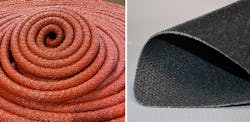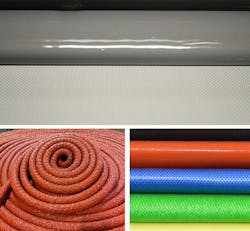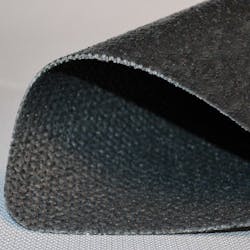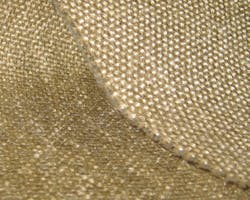The Benefits of Coated Textiles in High-Temperature Applications
Coated textiles are used in a wide range of applications in industries including aerospace, aluminum, oil & gas, robotics, welding, mechanical insulation, etc. These textiles consist of knit and woven broad and narrow fabrics, and other textiles such as ropes, tapes, and sleevings that are woven or knit. Used in high-temperature applications or in extreme environments, coated fabrics and textiles can be made with varying compositions to provide a range of different benefits.
For example, a robot cover needs to have high flexural resistance. An aromatic polyamide substrate coated with silicone would be better in this application than a fiberglass fabric substrate. An application requiring high abrasion resistance would benefit from a heavy-weight fiberglass fabric coated with a refractory compound.
There are multiple combinations of substrates and coatings that can provide not only high-temperature resistance but abrasion, chemical, flame, and UV resistance as well.
Silicone Rubber Coatings
Silicone rubber provides a wealth of benefits when used to coat fabrics and textiles for high-temperature applications. It offers a high level of thermal resistance in temperatures up to 572°F (300°C), and can often exhibit superior elongation, creep, thermal conductivity, tear strength, and fire resistance when exposed to extreme temperatures.
In addition to heat resistance, silicone rubber also has a high level of chemical and abrasion resistance.
By combining different substrates with varying formulations of silicone compounds, a custom-coated fabric or textile can be developed to address application requirements. These substrates can include fiberglass, Nomex, Kevlar, silica, nylon, etc.
The Properties of Silicone Coated Substrates
Silicone rubber is generally non-reactive, stable, and resistant to extreme environments and temperatures from −70 to 572°F (−55 to 300°C) while still maintaining its useful properties. When applied to a substrate and cured, silicone rubber can enhance the properties of the substrate and provide the following features:
- Abrasion and corrosion resistance
- Chemical resistance
- Durability (working temperatures of -94 to 1,022°F (-70 to 550°C)
- Flexural resistance
- Flame resistance
- Heat resistance
- Oil & water resistance
- Weather resistance
- Fabrics variable weight range (7 to 90 oz/y2 (237 to 3052 g/m2))
Applications of Silicone Coated Fabrics and Textiles
Silicone-coated fabrics and textiles are present in multitudes of industrial applications. Below are the more common applications within certain industries:
Aerospace
- Cargo covers
- Cargo bay liners
- Plenum seals
- Engine seals
- Thermal insulation barriers
- Smoke & vapor barriers
- Fire-resistant barriers
General Industrial
- High-temperature seals & gaskets
- Tadpole gasket seals
- Oven seals
- Furnace seals
- Insulation blankets
- Expansion joints
- Door seals
Oil & Gas
- Thermal insulation jackets
- Removable/reusable insulation blankets
- Pipe wrapping for color coding and personnel protection
Welding
- Welding blankets & curtains
- Welding drop cloths
- Welding habitats
- Robot covers
Aluminum
- External cathode bar seals
- Anode bar seals
- Flexible manifold boot seals
- Crucible lid seals
- Robot covers
Refractory Compounds
Refractories or refractory materials are resistant to decomposition by pressure, chemical attack, and heat, while maintaining their strength at temperatures typically above 1,000°F (538°C). As with silicone, when a refractory compound is used for fabric coating, it enhances the properties of the fabric to allow for extended use in certain applications.
For example, refractory-coated fiberglass fabric is commonly used in spark curtains for rail grinders when reforming the rails. These curtains are suspended off the side of the rail grinder to absorb the sparks resulting from the rail grinding process. The curtains hang very low to the tracks and thus are subject to abrasion during the grinding process.
Heavy-weight fiberglass combined with a refractory compound addresses the abrasion-resistant requirement of this application, keeping the curtains in service for an extended period of time.
Refractory-coated substrates are widely used in the primary aluminum industry due to the extreme nature of the manufacturing process, and for furnaces, ovens, and kilns which require resistance to pressure and high temperatures. Adding silicone to a refractory-coated fabric further enhances the protective properties.
Vermiculite Coating
Vermiculite has been used as a fire-protective surface coating for over 20 years. It has a low density and impressive insulation properties and is used to impart a high degree of fire protection to many products in a variety of industries.
Vermiculite expands significantly when exposed to heat. This makes it an excellent choice as a coating for fabrics that are used in high-temperature applications. When coated on a base fabric or textile, the vermiculite will cause heat to disperse evenly across the surface of the fabric when in operation. A vermiculite coating will also enhance the temperature and abrasion resistance properties of a fabric or textile.
When a fiberglass substrate is coated with vermiculite it provides great resistance against sparks, burning, flame impingement, molten splash, and corrosion. It will also provide great thermal insulation properties, allowing it to be used in applications that require heat resistance such as continuous furnaces or tray pads for use in secondary aluminum smelters.
Vermiculite-coated fabrics are typically used as seals, gaskets, welding blankets & curtains, and assorted thermal barriers.
Ceramic Coating
Ceramic-coated fabrics are a popular choice in high-temperature applications as they provide a wealth of desirable properties including high strength, excellent wear resistance, and low thermal conductivity. Ceramic coatings enhance textiles by improving both the dimensional and thermal stability properties of the base textile. They fray less than other fabrics during the fabrication process and have improved weather, heat, and flame resistance than other coatings.
The high flame resistance makes ceramic-coated fabrics an excellent choice for use in aircraft applications. Other applications for ceramic-coated fabric and textiles include molten metal splash protection, thermal insulation seals, insulation blankets & pads, and personnel & equipment protection.
Depending on the requirements of your application, there are many combinations of fabrics/textiles and coatings available to address your specific needs. Consulting with a company that has extensive materials science knowledge and experience will help find the best solution for your application.



